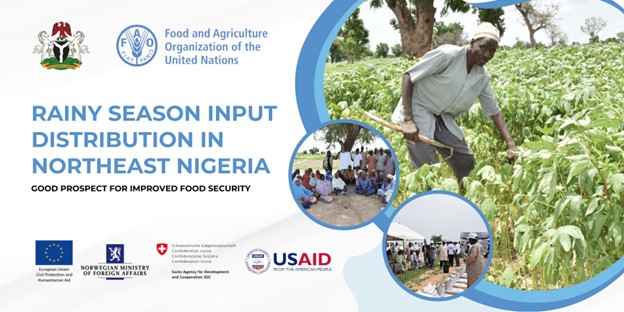Maiduguri – The Food and Agriculture Organization of the United Nations (FAO) has launched the 2024...
A Paradigm Shift for Conflict-Affected Rice Producers in Rural Borno
23 September 2019
23 September 2019

Key facts
Rice consumption in Nigeria peaked at around seven million tonnes in 2018, keeping the West African country as Africa’s largest consumer.
The Jere Bowl in Borno, comprising 22 000 hectares of moist farmland, can contribute more than 30 000 tonnes to the country’s rice production annually; and simultaneously provide livelihoods...
FAO trains farmers on use and handling of agrochemicals
20 September 2019
20 September 2019

Kaduna - Agriculture has remained the highest employer in Nigeria, with more than one-third of the country’s over 200 million people engaged in the sector. The majority of Nigeria’s agricultural actors are smallholder farmers with limited alternative sources of livelihood.
Farmers are exposed to high health risks while using agrochemical products...
From Subsistence to Markets – FAO, Yobe State Government and Stakeholders Brainstorm To Enhance Agriculture Production
19 September 2019
19 September 2019

Yobe-Damaturu - For agriculture to become more sustainable and productive in Africa, governments at all levels must be at the center of agriculture programmes. These were the words of FAO Representative in Nigeria, Suffyan Koroma at the opening of a retreat organized by the Yobe State government to design a...
FAO distributes 3 976 farm implements, agro-inputs to farmers, train 280 on vegetable value chain in Kaduna state
07 August 2019
07 August 2019

Abuja -Smallholders mostly suffer the hazard of post-harvest losses, due largely to the lack of capacity to add value to their produce and modern farming equipment to ease the process. This among other challenges have continued to hurdle intervention efforts to alleviate rural poverty.
The Food and Agriculture Organisation of the...

In Borno, conflict-affected youth are being supported for employment and income generation through an agriculture support programme funded by the European Union Trust Fund (EUTF). As part of the programme, the Food and Agriculture Organization of the United Nations (FAO) recently launched a massive livestock restocking campaign, chiefly targeting vulnerable...



